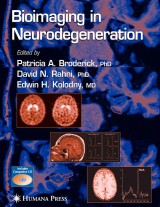Details

Bioimaging in Neurodegeneration
Contemporary Neuroscience
|
CHF 236.00 |
|
| Verlag: | Humana Press |
| Format: | |
| Veröffentl.: | 05.11.2007 |
| ISBN/EAN: | 9781592598885 |
| Sprache: | englisch |
| Anzahl Seiten: | 314 |
Dieses eBook enthält ein Wasserzeichen.
Beschreibungen
Bioimaging is in the forefront of medicine for the diagnosis and helps to predict the progression of AD via mild cognitive treatment of neurodegenerative disease. Conventional magnetic impairment (MCI) studies. resonance imaging (MRI) uses interactive external magnetic fields Novel neuroimaging technologies, such as neuromolecular and resonant frequencies of protons from water molecules. imaging (NMI) with a series of newly developed BRODERICK ® However, newer sequences, such as magnetization-prepared rapid PROBE sensors, directly image neurotransmitters, precursors, acquisition gradient echo (MPRAGE), are able to seek higher and metabolites in vivo, in real time and within seconds, at separate levels of anatomic resolution by allowing more rapid temporal and selective waveform potentials. NMI, which uses an imaging. Magnetic resonance spectroscopy (MRS) images electrochemical basis for detection, enables the differentiation of metabolic changes, enabling underlying pathophysiologic neurodegenerative diseases in patients who present with mesial dysfunction in neurodegeneration to be deciphered. Neuro- versus neocortical temporal lobe epilepsy. In fact, NMI has some 1 chemicals visible with proton H MRS include N-acetyl aspartate remarkable similarities to MRI insofar as there is technological (NAA), creatine/phosphocreatine (Cr), and choline (Cho); NAA dependence on electron and proton transfer, respectively, and is considered to act as an in vivo marker for neuronal loss and/or further dependence is seen in both NMI and MRI on tissue neuronal dysfunction. By extending imaging to the study of composition such as lipids.
Parkinson’s Disease.- Magnetic Resonance Imaging and Magnetic Resonance Spectroscopy in Parkinson’s Disease.- Positron Emission Tomography and Single-Photon Emission Tomography in the Diagnosis of Parkinson’s Disease.- Positron Emission Tomography in Parkinson’s Disease.- [123I]-Altropane SPECT.- Positron Emission Tomography and Embryonic Dopamine Cell Transplantation in Parkinson’s Disease.- Alzheimer’s Disease.- Neurotoxicity of the Alzheimer’s ?-Amyloid Peptide.- Functional Imaging and Psychopathological Consequences of Inflammation in Alzheimer’s Dementia.- Neurotoxic Oxidative Metabolite of Serotonin.- Predicting Progression of Alzheimer’s Disease With Magnetic Resonance.- Stages of Brain Functional Failure in Alzheimer’s Disease.- Epilepsy.- Neocortical Epilepsy.- Pediatric Cortical Dysplasia.- Bioimaging L-Tryptophan in Human Hippocampus and Neocortex.- In Vivo Intrinsic Optical Signal Imaging of Neocortical Epilepsy.- Intraoperative Magnetic Resonance Imaging in the Surgical Treatment of Epilepsy.- Periodic Epileptiform Discharges Associated With Increased Cerebral Blood Flow.- Imaging White Matter Signals in Epilepsy Patients.- Leukodystrophy (White Matter) Diseases.- Overview of the Leukoencephalopathies.- Pyramidal Tract Involvement in Adult Krabbe’s Disease.- Imaging Leukodystrophies.- Advanced Magnetic Resonance Imaging in Leukodystrophies.- Childhood Mitochondrial Disorders and Other Inborn Errors of Metabolism Presenting With White Matter Disease.- Mitochondrial Disease.
New imaging sensors, molecular probes, and neuromarkers for faster temporal resolution, smaller spatial resolution, and higher anatomic accuracy have made brain neuroimaging highly valuable in studying neuropathologies. Provocative insights into how the human brain actually works in real time and in vivo are now possible. In Bioimaging in Neurodegeneration, prominent physicians, researchers, and inventors of cutting-edge technologies review the new imaging tools available for diagnosing, treating, and discovering the underlying causes of Parkinson's and Alzheimer's disease, epilepsy, and leukodystrophy. The new technologies demonstrated include novel sequences for magnetic resonance imaging (MRI), such as magnetization-prepared rapid acquisition gradient echo (MPRAGE); proton magnetic resonance spectroscopy (1H MRS); new tracers for positron emission tomography (PET) and single-photon emission tomography (SPECT), such as tropane analogs and altropane; neuromolecular imaging (NMI) of neurotransmitters directly in brain synapses of epilepsy patients with unique carbon-based electrochemical sensors; and intrinsic optical signal imaging (IOS), useful in diagnosing "spreading epileptiform depression." NMI and IOS also promise applications in intraoperative guided neurosurgery. Pediatric mitochondrial cytopathies are discussed, as well as nanotechnology, microtechnology, nanoimaging, and microimaging are presented. Devices for diagnosing tumors are also described. To enhance understanding of the potential of these developing technologies, a companion compact disk contains color versions of selected black-and-white illustrations used in the book. <BR>
Authoritative and state-of-the art, Bioimaging in Neurodegeneration offers both the physician and researcher a critical survey of the best new technologies for studying neurodegeneration, as well as describing their optimal use in the diagnosis and treatment of specific neurodegenerative diseases.
Authoritative and state-of-the art, Bioimaging in Neurodegeneration offers both the physician and researcher a critical survey of the best new technologies for studying neurodegeneration, as well as describing their optimal use in the diagnosis and treatment of specific neurodegenerative diseases.
Includes supplementary material: sn.pub/extras

















